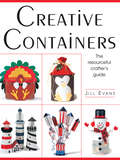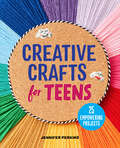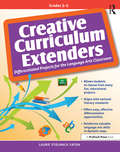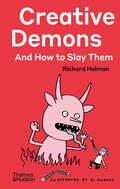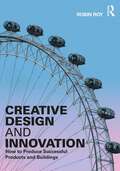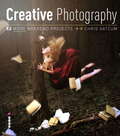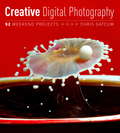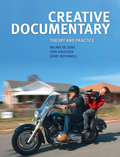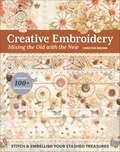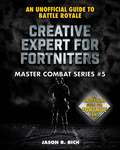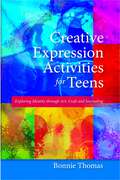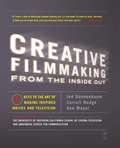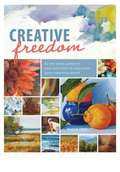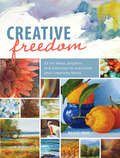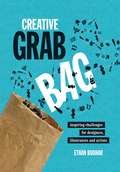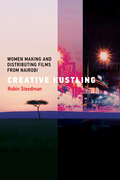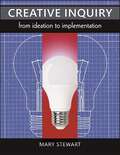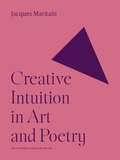- Table View
- List View
Creative Containers: The Resourceful Crafter's Guide
by Jill EvansFast, fun and easy projects to make with recycled materials! Author and designer Jill Evans has created 50 great projects made from recycled containers, all of which are perfect for crafters of any skill level, even children! Ranging from a darling penguin for Christmas and a kooky witch for Halloween to home decor items like lighthouses and candleholders, crafters will find creative ideas for any occasion. And, the best thing is, each project can be completed using common craft tools and materials for less than $5! Full-size patterns are included for each project, and readers will use food cans, potato chip canisters, beverage cups, and cookie tins to make these functional and earth-friendly pieces!
Creative Convergence: The AI Renaissance in Art and Design (Springer Series on Cultural Computing)
by James Hutson Jason Lively Bryan Robertson Peter Cotroneo Martin LangEmbark on a journey that transcends the boundaries of art and technology in the groundbreaking realm of Creative Convergence: The AI Renaissance in Art and Design. This isn't just another book on art and technology- it's a journey that sparks curiosity, fuels innovation, and challenges traditional artistic boundaries. Discover the power of generative Artificial Intelligence (AI) as it melds with human expression, propelling artistry into uncharted territories and redefining traditional notions of both originality and creativity. The text is not just about art or AI; it is about the fusion of both, catalyzing a creative revolution that challenges previous assumptions about human-machine collaboration and how ideation, conceptualization, process and execution are radically rethought. Have you ever wondered how/will AI revolutionize training, education and execution in art and design? Delve into this captivating treatment that contextualizes the disruptions we are experiencing today in the technological innovations and artistic responses and integrations of the past five hundred years. Human creativity has always struggled against technological advance, but ultimately integrated and redefined what "art" is in each era. As such, you will see how AI can be incorporated in various artistic disciplines in this study. Explore real-world case studies that showcase AI's practical impact on 3D design, drawing, digital art, and even web design. The book also addresses the controversial question: Can AI be a co-creator in the creative and artistic process, even assisting in creating an original, signature style? Brace yourself for revelations that will challenge your perceptions of traditional artistry.
Creative Cosplay: Selecting & Sewing Costumes Way Beyond Basic
by Amanda HaasAn inspirational guide to sewing cosplay Boldly enter the world of cosplay and gain the confidence to design the costume of your dreams! Award-winning cosplayer Amanda Haas helps you translate your ideas from fiction to reality as you research costumes, shop for fabrics, mash-up patterns, and present your cosplay at a competition. A gorgeous photo gallery will have you frantic to join the cosplay community, while the author’s seasoned advice will give you the courage to take the first step. Bonus project: Sew a bum bag to carry your keys and other essentials to a con. Learn the art of making and wearing designer-quality costumes that will transform your persona. Turn fiction into fashion! A step-by-step guide to designing your own cosplay Dive into the fun world of cosplay with the author’s trusted advice Step up your cosplay costumes with inspirational photos, techniques, and more
Creative Crafts for Teens: 25 Empowering Projects
by Jennifer PerkinsDiscover your own authentic style with this book of empowering arts and crafts for teens!Get ready to express yourself through art with crafting projects created especially for teenagers. Inside, you'll explore 25 hands-on projects that are super-fun to make, but can also help boost your confidence, encourage self-care, and celebrate your favorite people—that's the power of art!Flex your creativity—Whether it's a Sandy Beach Vibes Vase, a Quirky and Colorful Corkboard, or Lavender Luxuries shower steamers, explore how making things yourself can get you excited and inspired.Art for everyone—These projects include simple instructions and helpful photos, and use basic materials that are easy to find—no fancy tools or artistic experience required!Make it your own—Each craft includes a "Crafty Confidence" tip to get you started if you're feeling stuck, and an "Advanced Crafting" tip to add a little something extra if you're feeling daring.Craft your way to greater confidence with Creative Crafts for Teens.
Creative Curriculum Extenders: Differentiated Projects for the Language Arts Classroom (Grades 3-5)
by Laurie Stolmack EatonCreative Curriculum Extenders: Projects for the Language Arts Classroom (grades 3-5) is an easy-to-use source of reading and writing curriculum projects that help teachers differentiate instruction. Each page has four in-depth, open-ended, and varied project choices, allowing students to pick a project that fits their needs, ability level, and learning style. Some of the categories that the projects cover are novels, poetry, fairy tales, autobiographies, descriptive communications, nonfiction, and more. Each page is graphically interesting and perfect to post on a bulletin board or in a learning center for enrichment or extra credit choices.Grades 3-5
Creative Demons and How to Slay Them
by Richard HolmanAn inspirational guide to help creatives overcome obstacles and find success—filled with tips, anecdotes, and encouragement for anyone whose working life depends on imaginative thinking. If you have ever embarked on a creative endeavor then there’s a good chance that at some point during your journey you will have been paralyzed by the demons of self-doubt, fear of failure, or just lack of inspiration. Enter Creative Demons and How to Slay Them, where you will learn how to banish your mind-forged monsters, one by one, no matter how grotesque or scary they may seem to be. Creativity expert Richard Holman draws on inspirational anecdotes from science, art, history, philosophy, nature, music, and contemporary culture to provide you with your very own mental armor for every stage of the creative process. Discover how to fight off the demons of procrastination, the blank canvas, and distraction through the experiences of Leonardo da Vinci, John Steinbeck, Sister Corita Kent, Dr. Seuss, Yayoi Kusama, and many others. Then, once you have started, there are tips on how to avoid the issues that plague all creatives, from self-doubt or “playing it safe” to lack of resources. Using Hokusai, Alfred Hitchcock, and Herbie Hancock as case studies, Holman presents the necessary tools to handle criticism, disappointment, and any other bumps along the creative road. Say goodbye to your demons and make your next creative project better than you could have imagined.
Creative Design and Innovation: How to Produce Successful Products and Buildings
by Robin RoyUsing many real-world examples and cases, this book identifies key factors and processes that have contributed to the creation of successful new products, buildings, and innovations, or resulted in some failures. Such factors include the creativity of individuals and groups, their sources of inspiration, the processes of creative design and innovation, and the characteristics of the products, buildings, and innovations themselves. Much has been written about creativity and innovation, but what helps to foster creativity, enable creative ideas to be translated into practical designs, and ensure those new products or buildings succeed as innovations on the market or in use? This book discusses these elements through the author’s origination and analysis of examples and case studies ranging from the revolutionary innovation of the smartphone, through radical innovations in domestic appliances and sustainable housing, to creative designs of contemporary jewellery. The broad range of examples and cases include product and fashion design, filmmaking and fine art, as well as industrial design, engineering, and architecture, offering lessons for creatives, designers, and innovators from many subject backgrounds. Analysis of the different factors, successes, and failures are presented in text boxes throughout the book to allow readers to easily understand the key lessons from each example or case, with numerous colour visuals, diagrams, and charts for illustration. This book is a must-read for a broad audience interested in creativity, design, and innovation, including practitioners in design, engineering, architecture, and product management, and students and instructors of those subjects.
Creative Digital Photography 52 More Weekend Projects: 52 More Weekend Projects
by Chris GatcumPhotography is about so much more than technically perfect images: most photographers want to experiment, try something new, create visual surprises – above all, have fun. <P><P>Chris Gatcum’s first collection of creative exercises for the hobbyist photographer, Camera Creative, was a worldwide best-seller, and in this sequel he reveals more of the techniques that anyone can master, and that are guaranteed to result in pictures with the ‘wow’ factor. <P> The techniques include: still lifes frozen in ice; 3D, micro and macro on a budget; solar photography; and recreating Polaroid effects, and range in duration from a few minutes to an afternoon – so there will always be a new trick for you to master!
Creative Digital Photography: 52 Weekend Projects
by Chris GatcumThis is a fun collection of handy weekend projects, offering expert insights and clear step-by-step instructions across the field of photography. Learn diverse techniques for taking and processing surprising photos, and discover how to make useful equipment for minimal cost.
Creative Digital Photography: 52 Weekend Projects
by Chris GatcumDo you wish you could take better, more exciting photos? Now you can, with 'Creative Digital Photography: 52 Weekend Projects'. Through this collection of handy weekend projects you will get expert insights and clear step-by-step instructions across the field of photography so you too can learn diverse techniques for taking and processing photos, and discover how to make useful equipment for minimal cost. Whether you're making a simple diffuser for your flash, setting up a time-lapse shoot or simply taking a chance and tossing your camera in the air, you will develop your skills, making your own stunning images and standing out from the crowd. Designed for photographers of all levels with the projects graded in complexity.
Creative Documentary: Theory and Practice
by Erik Knudsen Jerry Rothwell Wilma de JongWhat does it mean to be a documentary filmmaker in today's world? How are new technologies changing documentary filmmaking? What new forms of documentary are emerging? Recent technological developments have made the making and distribution of documentary films easier and more widespread than ever before. Creative Documentary: Theory and Practice is an innovative and essential guide that comprehensively embraces these changing contexts and provides you with the ideas, methods, and critical understanding to support successful documentary making. It helps the aspiring 'total filmmaker' understand the contemporary contexts for production, equipping you also with the understanding of creativity and visual storytelling you'll need to excel. Bridging the gap between theory and practice, it outlines the contemporary, institutional, practical and financial contexts for production - always encouraging innovation and originality. Key features: Five sections covering creativity and creative documentary and the contemporary creative industries: strategies for developing documentary ideas; the art of documentary narrative; digital production methods; new documentary forms; distribution and financing. Provides a comprehensive overview of critical thought and techniques in digital documentary filmmaking. Authors and specialist contributors combine the experience, knowledge and skills of academics and media professionals working in the industry. Practical case studies support analysis and reflection. Exercises, checklists, interviews with professionals and further reading materials accompany each chapter. A historical overview of world documentary. Creative Documentary: Theory and Practice is an essential guide for those engaged in the study and practice of documentary theory and making, as well as key reading for those more broadly interested in video, film and media theory and production.
Creative Embroidery, Mixing the Old with the New: Stitch & Embellish Your Stashed Treasures
by Christen BrownPut your stashed, hoarded, and handed-down bits and pieces to creative use with projects, photos, tips, and a library of 100+ stitches! In this beautifully illustrated guide, craft teacher Christen Brown walks readers through innovative uses for all kinds of embellishments—like lace, vintage linens and hankies, trims and ribbons, buttons of all sorts, and vintage notions—through techniques and projects. And if you want to add more unique stash pieces, she provides tips on finding the good stuff, both in-person and online. Get tips for taking care of your treasures, from cleaning vintage finds to fiber identification Embroider your stashed treasures with nineteen stash project ideas, three step-by-step projects, and a robust gallery to get started Explore a wide variety of projects from feminine to whimsical, functional to frivolous, and old school to contemporary!
Creative Expert for Fortniters: An Unofficial Guide to Battle Royale (Master Combat #5)
by Jason RichGet the most out of Fortnite Battle Royale&’s popular Creative mode with Creative Expert. This all-new, unofficial, illustrated guide series will turn you into a master Fortnite: Battle Royale gamer by uncovering all the best strategies and secrets of this wildly popular game. Whether you play Fortnite: Battle Royale on a PC, Mac, Xbox One, PlayStation 4, or your mobile device, you&’ll find everything you need to stay at the top of your game. Each book is packed with useful insider tips on topics like, staying alive longer, exploring, collecting a powerful arsenal, building, and snagging more victories during each match. When it comes to achieving #1 Victory Royale, the Fortnite Battle Royale: Master Combat Series provides the ultimate competitive edge. Thanks to this illustrated how-to guide, you can create inspired custom builds and design a unique environment for hosting matches of up to 16 players. There are plenty of tools available in Creative mode to make your own island designs from scratch. This book will take you through each one and give you tips for staging incredible combat scenarios and customizing fighting locations so you and your online friends can be challenged in ways you&’ve never experienced before. Have fun being the master of your Fortnite world with Creative Expert.
Creative Expression Activities for Teens
by Bonnie ThomasCoping with life's stresses is difficult for everybody, but can be especially challenging for teenagers, who often feel isolated and misunderstood. Creative expression through art, craft, and writing is a natural and effective way of helping young people to explore and communicate personal identity. This book is bursting with art and journal activities, creative challenges, and miniature projects for bedrooms and other personal spaces, all of which help teenagers to understand and express who they are and what is important to them. These fun ideas can be tailored to suit the individual, and require minimal equipment and even less artistic know-how, so can be enjoyed by all. The book concludes with a useful section for counselors and other professionals who work with young people, which explains how these activities can be incorporated into treatment goals. This imaginative and insightful book is a useful resource for all therapists, social workers, and counselors who wish to encourage self-expression in teenagers.
Creative Filmmaking from the Inside Out
by Jed Dannenbaum Carroll Hodge Doe MayerFive keys to creating authentic, distinctive work, whether you are a student, professional or simply love making films on your own For Creative Filmmaking from the Inside Out, three professors at the renowned University of Southern California School of Cinema-Television interviewed fifteen outstanding filmmakers, then distilled their insights into the "Five I's" of creativity. Learn how to: Uncover your unique creative voice (Introspection) Work from real-life observations and experience (Inquiry) Draw on your nonconscious wells of creativity (Intuition) Strengthen your creative collaborations (Interaction) Communicate at the deepest level with your audience (Impact) This comprehensive approach provides practical exercises that will enrich and transform your work, whether you are looking for a story idea, lighting a set, editing a scene or selecting a music cue. The participating filmmakers, who have collectively won or been nominated for 39 Oscars and 27 Emmys, are: Anthony Minghella, writer-director (The English Patient); Kimberly Peirce, writer-director (Boys Don't Cry); John Lasseter, writer-director-producer (Toy Story); John Wells, writer-producer (ER); Hanif Kureishi, writer (My Beautiful Laundrette); Pamela Douglas, writer (Between Mother and Daughter); Renee Tajima-PeÑa, director-producer (My America...or, Honk If You Love Buddha); Ismail Merchant, producer (The Remains of the Day); Jeannine Oppewall, production designer (L.A. Confidential); Conrad L. Hall, cinematographer (American Beauty); Kathy Baker, actor (Picket Fences); Walter Murch, sound designer-editor (Apocalypse Now); Lisa Fruchtman, editor (The Right Stuff); Kate Amend, editor (Into the Arms of Strangers); and James Newton Howard, composer (The Sixth Sense).
Creative Flash Photography
by Tilo GockelMake a big impression with small flashes! In this book, Tilo Gockel shows you how to make magic by mastering the use of light. You will learn how to use speedlights to create amazing photographs in any lighting situation. Tilo uses 40 lighting workshops to teach his methods for producing impressive flash shots in portrait, fashion, macro, food, still life, and high-speed photography.The richly illustrated, easy-to-understand workshops are filled with recommendations and instructions for flash setups, detailed lighting diagrams, and tips and tricks for how to achieve the look of high-end studio shots using simple, accessible equipment, even in your own home. Also included is information on the settings that will help you master complex multi-flash situations, as well as tips on how to create cost-effective, self-built accessories.Foreword by Strobist.com's David Hobby.
Creative Foundations: 40 Scrapbook and Mixed-Media Techniques to Build Your Artistic Toolbox
by Vicki BoutinYes, You CAN Do It! Internationally recognized artist and teacher Vicki Boutin takes the all mystery out of those scrapbook and mixed-media techniques you thought you could never do! She'll be with you every step of the way as you learn to paint, stamp, emboss and burnish your way to creating beautiful, unique and individual art. In Creative Foundations you'll find: 40 step-by-step demonstrations for easy, fun, messy, funky, innovative and customizable techniques for creating backgrounds, textures, supplements and embellishments. 40 finished single-technique pieces of art and an additional 16 gallery pieces created by Vicki using a "recipe" of two to five separate techniques layered together. 24 more exciting and inspiring gallery pieces created by powerhouse contributors, including Rhonna Farrer, Wendy Vecchi, Kelly Purkey and others. So gather your arts and crafts supplies, choose your inspiration and get down to it! Whether you're making scrapbook pages, cards, wall art, décor or something else entirely, with these Creative Foundations, you'll find that the possibilities are endless.
Creative Freedom: 52 Art Ideas, Projects and Exercises to Overcome Your Creativity Block
by Maggie PricePaint outside the lines! Jumpstart your creativity and inject new life into your art. Struggling to get started? Paralyzed by the fear of failure? Find yourself falling back on the same colors again and again? Just plain stuck? It happens to every artist sooner or later. What can you do to get unstuck quickly and painlessly? Creative Freedom presents 52 strategies for getting out of ruts and venturing beyond your comfort zone, courtesy of 25 artists who have been there, done that. Each approach is illustrated with a step-by-step painting demonstration. Together, they help you experiment with different mediums, new color combinations, fresh approaches to favorite subjects, and more. Try one a week for a year of creative adventure. Or dip in whenever you're feeling inspired. You may be surprised at the creative liberation that comes from... Painting with your other hand. Going big with your canvas and brushes. Painting fast with 10-minute studies. Limiting your palette. Starting with a random line drawing or custom painting surface. Zooming in on one small detail of a landscape for abstract results. Copying the work of an Old Master. Featuring an exciting variety of styles and mediums (oil, watercolor, acrylic and pastel), novel perspectives and an invigorating sense of play, this book is sure to generate creative sparks and joyful painting sessions. Getting unstuck has never been so fun!
Creative Freedom: 52 Art Ideas, Projects and Exercises to Overcome Your Creativity Block
by Maggie PricePaint outside the lines! Jumpstart your creativity and inject new life into your art. Struggling to get started? Paralyzed by the fear of failure? Find yourself falling back on the same colors again and again? Just plain stuck? It happens to every artist sooner or later. What can you do to get unstuck quickly and painlessly? Creative Freedom presents 52 strategies for getting out of ruts and venturing beyond your comfort zone, courtesy of 25 artists who have been there, done that. Each approach is illustrated with a step-by-step painting demonstration. Together, they help you experiment with different mediums, new color combinations, fresh approaches to favorite subjects, and more. Try one a week for a year of creative adventure. Or dip in whenever you're feeling inspired. You may be surprised at the creative liberation that comes from... Painting with your other hand. Going big with your canvas and brushes. Painting fast with 10-minute studies. Limiting your palette. Starting with a random line drawing or custom painting surface. Zooming in on one small detail of a landscape for abstract results. Copying the work of an Old Master. Featuring an exciting variety of styles and mediums (oil, watercolor, acrylic and pastel), novel perspectives and an invigorating sense of play, this book is sure to generate creative sparks and joyful painting sessions. Getting unstuck has never been so fun!
Creative Grab Bag
by Ethan BodnarPush the Limits of Your Creativity Creative Grab Bagcaptures the spirit of exploration and innovation#151;inside, you'll find inspiring work from 101 artists from around the world. Ethan Bodnar asked each artist to take on a task outside the realm of their normal work. Each task was randomly selected from a grab bag. The result is a collection of work brimming with creative energy. In this book, you'll find short biographies of the artists, examples of their typical work, their thoughts on the creative process, and images of their completed creative task. Here's a sampling of the creative grab bag tasks: Design a Building Make a Self-Portrait Make Art like a Child Design a Brand Create Visual Statistics Illustrate a Memory Illustrate Your Day Create a Collage Create a Sculpture Design a Book Cover Design an Album Cover Create a Photo Essay Photograph Strangers Design a Skateboard Design a Pair of Shoes Make a Wallpaper Pattern Design a Typeface Create an Animation Design a Character Creative Grab Bagalso features tear-out cards, so you can do the creative challenges yourself. Work together or in a group, and push the limit#151;you'll break out of your routine and take your work into unchartered territory.
Creative Grab Bag
by Ethan BodnarPush the Limits of Your CreativityCreative Grab Bag captures the spirit of exploration and innovation—inside, you'll find inspiring work from 101 artists from around the world. Ethan Bodnar asked each artist to take on a task outside the realm of their normal work. Each task was randomly selected from a grab bag. The result is a collection of work brimming with creative energy. In this book, you'll find short biographies of the artists, examples of their typical work, their thoughts on the creative process, and images of their completed creative task.Here's a sampling of the creative grab bag tasks:Design a BuildingMake a Self-PortraitMake Art like a ChildDesign a BrandCreate Visual StatisticsIllustrate a MemoryIllustrate Your DayCreate a Collage Create a SculptureDesign a Book CoverDesign an Album CoverCreate a Photo EssayPhotograph StrangersDesign a SkateboardDesign a Pair of ShoesMake a Wallpaper PatternDesign a TypefaceCreate an AnimationDesign a CharacterCreative Grab Bag also features tear-out cards, so you can do the creative challenges yourself. Work together or in a group, and push the limit—you'll break out of your routine and take your work into unchartered territory.PLEASE NOTE: Tear-out cards are NOT included with the ebook version of this title
Creative Grab Bag: Inspiring Challenges for Artists, Illustrators and Designers
by Ethan BodnarPush the Limits of Your CreativityCreative Grab Bag captures the spirit of exploration and innovation—inside, you'll find inspiring work from 101 artists from around the world. Ethan Bodnar asked each artist to take on a task outside the realm of their normal work. Each task was randomly selected from a grab bag. The result is a collection of work brimming with creative energy. In this book, you'll find short biographies of the artists, examples of their typical work, their thoughts on the creative process, and images of their completed creative task.Here's a sampling of the creative grab bag tasks:Design a BuildingMake a Self-PortraitMake Art like a ChildDesign a BrandCreate Visual StatisticsIllustrate a MemoryIllustrate Your DayCreate a Collage Create a SculptureDesign a Book CoverDesign an Album CoverCreate a Photo EssayPhotograph StrangersDesign a SkateboardDesign a Pair of ShoesMake a Wallpaper PatternDesign a TypefaceCreate an AnimationDesign a CharacterCreative Grab Bag also features tear-out cards, so you can do the creative challenges yourself. Work together or in a group, and push the limit—you'll break out of your routine and take your work into unchartered territory.PLEASE NOTE: Tear-out cards are NOT included with the ebook version of this title
Creative Hustling: Women Making and Distributing Films from Nairobi (Distribution Matters)
by Robin SteedmanThe first book-length study of Nairobi-based female filmmakers—and how their dogged pursuit of opportunities, innovation, and cultural support is defining an industry.Nairobi, the capital of Kenya, is home to something extraordinary and unlikely: in this city, the most critically acclaimed filmmakers—both directors and producers—are women. Yet, across the globe, women make up less than 10 percent of film directors. In Creative Hustling, Robin Steedman takes a closer look at these remarkable women filmmakers, viewing them not only as auteurs, but also as entrepreneurs, who are taking the lead in creating a vibrant, and atypical, screen media industry. To understand their achievement, Steedman theorizes hustling as not only a practice born out of necessity but also an inventive labor in its own right—one that can create new spaces of community by carving new entrepreneurial pathways.Through original empirical field research gathered over eight months in Nairobi, Steedman describes how female filmmakers go about trying to create their films, as well as the challenges they face in distributing those films in their local market. Along the way, she traces the history of the industry over the last fifteen years, the lack of state support for these filmmakers&’ undertakings, the low social standing of the profession, and the transnational conflicts that arise when Euro-American funding is at the heart of Kenyan cinema.Creative Hustling is a major contribution to the task of de-Westernizing media industry studies, imparting important lessons about what it takes to create and distribute creative work in a global age increasingly marked by uncertain work.
Creative Inquiry: From Ideation to Implementation
by Mary StewartCreative Inquiry introduces both undergraduate students and general readers to the exploratory mindset and hands-on skills essential to the cultivation and implementation of new ideas. Using active learning, this book combines concise explanations and real-world examples with engaging exercises for readers to complete. The writing style is conversational, yet substantial, and the examples given reflect a wide range of disciplines, from early aeronautics and linguistics to zoology.Creative Inquiry emphasizes the importance of direct experience, personal initiative, and the generation of new knowledge. Step by step, the exercises build the skills students need when they tackle the final self-designed Capstone project. Positioned at the end of major sections, five brief self-reflection papers are designed to help students assess their progress and revise their assignments. To encourage collaboration and strengthen metacognition, teams of three to six participants work together on these papers. This encourages an iterative mindset and provides extensive practice with writing. The appendix provides a lively and practical "Top Ten List" of writing strategies for students who need extra advice.
Creative Intuition in Art and Poetry (The A. W. Mellon Lectures in the Fine Arts #1)
by Jacques MaritainThe classic work on the sublime interplay between the arts and poeticsThis book explores the rich and complex relationship between art and poetry, shedding invaluable light on what makes each art form unique yet wholly interdependent. Jacques Maritain insists on the part played by the intellect as well as the imagination, showing how poetry has its source in the preconceptual activity of the rational mind. As Maritain argues, intellect is not merely logical and conceptual reason. Rather, it carries on an exceedingly more profound and obscure life, one that is revealed to us as we seek to penetrate the hidden recesses of poetic and artistic activity. Incisive and authoritative, this illuminating book is the product of a lifelong reflection on the meaning of artistic expression in all its varied forms.
